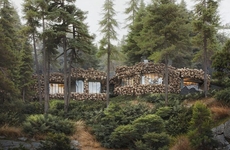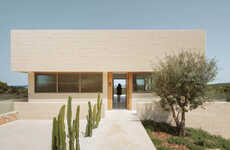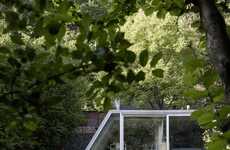
The Wooden Concrete House Makes the Most of Limited Products
Jamie Danielle Munro — May 21, 2014 — Art & Design
References: nestor-arch & contemporist
The Wooden Concrete House is distinctly made up of two types of material: wood and concrete, as the name so aptly suggests. The design was done by Nestor Sandbank Architecture, and the house is located in Israel.
When looking at the abode from both the front and the back, the main material used seems to be wood. However, upon closer inspection it's clear that the concrete is mingled throughout, adding an industrial aesthetic to the structure. The contrasting items used for building is what makes this piece of work so modern and fascinating. On the one hand, it exudes an industrial look, but the wood gives the house a cabin-like feel. It's opulence is added to even more on the inside, which features open spaces and luxurious furniture.
When looking at the abode from both the front and the back, the main material used seems to be wood. However, upon closer inspection it's clear that the concrete is mingled throughout, adding an industrial aesthetic to the structure. The contrasting items used for building is what makes this piece of work so modern and fascinating. On the one hand, it exudes an industrial look, but the wood gives the house a cabin-like feel. It's opulence is added to even more on the inside, which features open spaces and luxurious furniture.
Trend Themes
1. Contrasting Material Architecture - Disruptive innovation opportunity: Develop new building materials that combine contrasting elements, such as wood and concrete, to create unique aesthetic experiences.
2. Industrial Aesthetic - Disruptive innovation opportunity: Explore ways to incorporate industrial elements into residential architecture, creating a modern and edgy design style.
3. Luxurious Open Spaces - Disruptive innovation opportunity: Design innovative furniture and interior layouts that maximize open spaces in residential buildings, providing a sense of luxury and elegance.
Industry Implications
1. Architecture - Disruptive innovation opportunity: Collaborate with architects and designers to develop new techniques and materials that push the boundaries of traditional architectural design.
2. Construction - Disruptive innovation opportunity: Integrate unconventional building materials and methods into the construction industry, offering new possibilities for unique and sustainable structures.
3. Furniture - Disruptive innovation opportunity: Create high-end furniture designs that blend seamlessly with contrasting architectural elements, enhancing the overall aesthetic of modern homes.
3.8
Score
Popularity
Activity
Freshness























